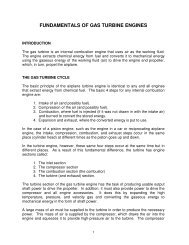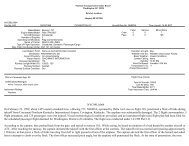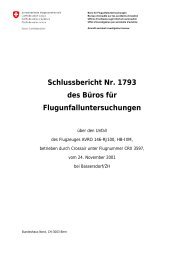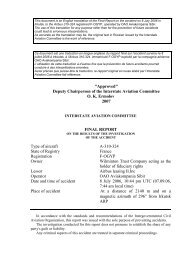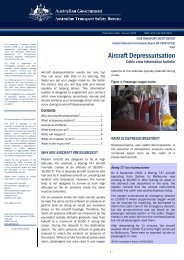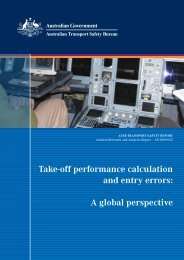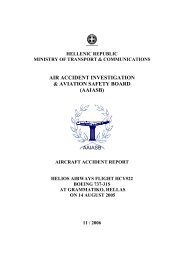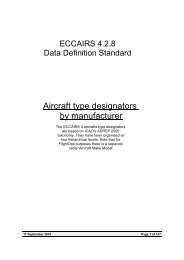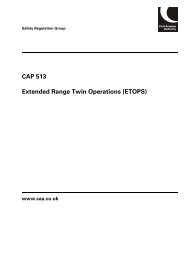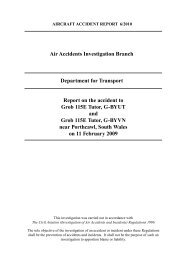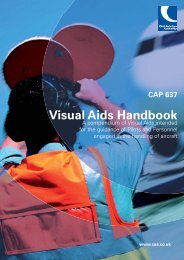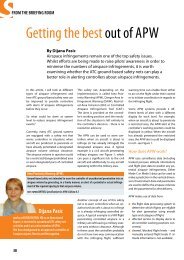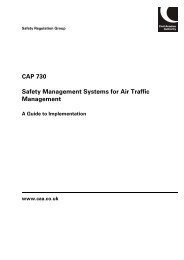CAP 772 - Birdstrike Risk Management for Aerodromes - SKYbrary
CAP 772 - Birdstrike Risk Management for Aerodromes - SKYbrary
CAP 772 - Birdstrike Risk Management for Aerodromes - SKYbrary
Create successful ePaper yourself
Turn your PDF publications into a flip-book with our unique Google optimized e-Paper software.
<strong>CAP</strong> <strong>772</strong> <strong>Birdstrike</strong> <strong>Risk</strong> <strong>Management</strong> <strong>for</strong> <strong>Aerodromes</strong><br />
4.2 The Lapwing and Golden Plover<br />
4.2.1 Lapwings prefer open habitats with low or sparse vegetation, especially grassland,<br />
such as aerodromes. Hence Lapwings may centre their activities on them <strong>for</strong> much<br />
of the year. In lowland Britain, numbers are usually at a minimum during the breeding<br />
season, the breeding population having declined significantly since 1970. Flocks<br />
begin to build in June or July as local birds disperse from breeding sites and, in<br />
particular, continental birds arrive in the UK. Some aerodromes provide attractive<br />
habitat to small numbers of Lapwing during the breeding season, but can attract<br />
substantial flocks of non-breeding birds towards the end of the summer. At this time,<br />
they may appear lethargic and reluctant to disperse because of the energetic strain of<br />
moulting. Once harvesting and ploughing are under way from August, making soil<br />
invertebrates particularly accessible, Lapwing numbers on aerodromes decline as<br />
they exploit these seasonal feeding opportunities. They remain relatively scarce on<br />
aerodromes until October or November when large flocks reappear with influxes of<br />
continental birds. Unless hard weather settles in, wintering numbers can remain high<br />
until spring migration in February and March. However, prolonged frozen ground or<br />
snow cover prevents Lapwings from feeding and they are <strong>for</strong>ced to move to seek<br />
better conditions further south or at the coast.<br />
4.2.2 Golden plover are slightly smaller than the Lapwing and much more difficult to detect<br />
on aerodromes because of their cryptic coloration. They are less common than<br />
Lapwing but wintering flocks can be very large and dense. Golden plover frequent<br />
similar habitats to Lapwings during the winter and use aerodromes in much the same<br />
way, often <strong>for</strong>ming mixed flocks. Feeding birds run, pause and up-end like Lapwings.<br />
Golden plover occur on aerodromes at night.<br />
4.3 Waders<br />
4.3.1 The Oystercatcher is primarily a coastal bird and specialist cockle predator but it will<br />
feed on other shoreline and soil invertebrates. On the coast, activity patterns are<br />
strongly influenced by tide state: repeated influxes onto an aerodrome can occur if no<br />
suitable roosting sites remain on mudflats or salt marsh around high tide.<br />
Oystercatchers are also often active at night. On coastal aerodromes they will nest<br />
on gravel islands surrounding lights and marker boards, breaking up paved surfaces,<br />
French drains and disturbed ground such as rabbit excavations. 'Piping parties',<br />
vociferous display flights, and mobbing of potential nest predators make nesting<br />
Oystercatchers very obvious.<br />
4.3.2 The Curlew occurs on mudflats and grassland, often in large flocks in winter, mostly<br />
around the coast but inland in smaller numbers throughout lowland Britain and<br />
Ireland. The Curlew nests on moors (up to 600 m above sea level) and farmland<br />
throughout much of Britain and Ireland, but breeding numbers have declined<br />
significantly and Curlews are absent from most of SE England and scarce in SW<br />
England. Nesting Curlews defend a large territory against other Curlews and,<br />
there<strong>for</strong>e, aerodromes rarely have more than one or two pairs. They are very obvious<br />
and present a potential birdstrike risk when displaying or defending nests against<br />
crows and potential predators but at other times are remarkably inconspicuous. They<br />
rarely alight on paved surfaces when nesting.<br />
4.3.3 Other Waders may appear on coastal aerodromes, especially when on migration in<br />
spring and autumn.<br />
4.4 Corvids<br />
4.4.1 Rooks are gregarious and feed on soil invertebrates, grain and seeds, and roots on<br />
farmland and aerodromes. They find much of their food by vigorously probing the<br />
upper soil horizons. They nest colonially in mature tall treetops (rookeries), where they<br />
March 2007<br />
Chapter 6 Page 3




